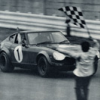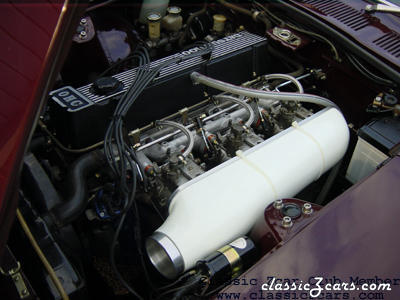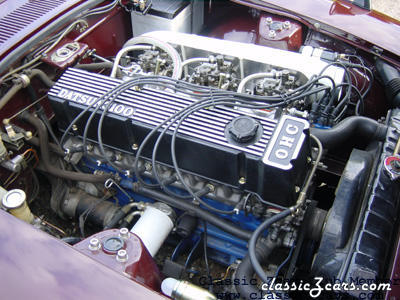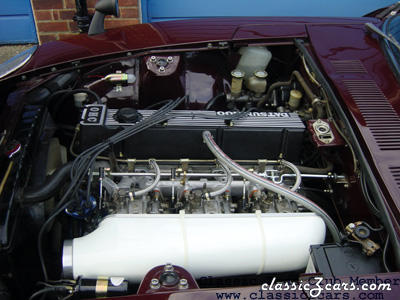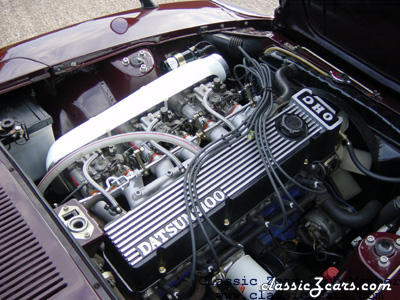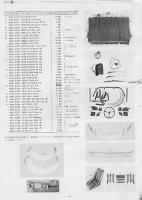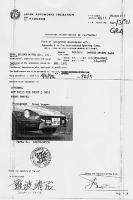Everything posted by HS30-H
-
260z Finland
That's a USA / North American export-spec. "260Z" ( note the "RLS30" prefix to the VIN / Chassis Number ). I think 2ManyZs is right about the year. This would have been one of the first of the cars with the big Federal bumpers. Sorry to say that there is not much information about the particular spec. of the car from the VIN / Chassis Number - it only acts as a clue for the fine details................. In my opinion, Zhome has a lot of information but is naturally rather USA / North American biased. That's fine in this case ( as the car seems to have been a USA / North American export version ) but it can lead you to think that nobody knows anything about your car if you happen to have a Japanese, UK, Australian or other market spec. version................. Great early to mid '70's colour!
-
New Camcover and Airbox
From the album: Fairlady 240ZG ( HS30-H )
-
New Camcover and Airbox
From the album: Fairlady 240ZG ( HS30-H )
-
New Airbox and Camcover
From the album: Fairlady 240ZG ( HS30-H )
-
New Camcover and Airbox
From the album: Fairlady 240ZG ( HS30-H )
-
Only $AUD 295,000.00
Gav, I have no idea how you could track down a car in Australia. Here in the UK we can ask the Vehicle Licensing authorities to do a search if we have specific information ( like a registration number or a VIN number ) but to get the full use of the system you have to be entitled to do so - for example, if you are a Police officer. Even then its not that much use, as they have lots of bad data and many of the things you would want to search for are not even on their computers.............. My 1970 Fairlady S30 rebuild-project car was registered with the UK authorities as a "Fairlady Turbo" ( ..... in 1970? - huh? ) by the dumwit punching the numbers into the computer. Bottom line is, if they don't know what it is they try the next nearest thing...................... My Fairlady 240ZG is the only genuine ZG in Europe ( by that I mean REALLY the only genuine factory-built 240ZG in Europe ) and it is hell trying to persuade the Insurance companies and the Police that it was the FACTORY that put the aerodynamic parts on it, and not a bad attempt at a Ferrari GTO replica on my part. Like I say, they only know what they think they know...... The S20 engine was fitted to two different generations of Skyline GT-R, as well as the 432. They built quite a few of them. It has always been quite sought after and consequently many more engines survived than cars that need them. Many owners of C10 and C110 series GT-R's seem to have a spare engine tucked away for a rainy day. Yes - they change hands for a fair few Yen ( about 1,000,000 for a rebuildable engine ) and it costs a few more to rebuild them properly. There are lots of trick bits available for them ( such as gear-drive oil-pump conversions, and fully-counterweighted stroker cranks ) and they can be made to scream. A nicely tuned and on-song S20 is something to hear, but ultimately they are limited by capacity and a "big" L-series will give more torque and last longer, with better driveability. My 432-R "Replica" project car is waiting for its S20 engine to arrive from Japan, and it has stalled all other work on the project. Even in stock form it will have cost a huge amount, and I only think its worth it because of the rarity value ( and the sound it makes ). Keep sniffing at chassis / VIN numbers out there in AUS, as you never know what you might find................. Good luck, Alan T.
-
"works" rally original parts
Mike, Its going to take me about three years to explain this to you! You have no idea how much they made for these cars, and the Japanese SPORTS OPTION parts lists alone ran for pages and pages. The genuine race parts were in some cases quite different to the Sports Option list parts, and that is where things get super complicated. Maybe you should narrow it down a bit and ask me about one specific type of part that you think you might come across. At least give me a target! By the way, if we are talking about genuine "Works" Rally parts - then "PART NUMBER ONE" would be a genuine Works S30 bodyshell. It seems that hardly anyone realises just how special these bodies were. Nissan did not simply pluck virgin bodyshells off the line and start to modify them; they started out with special pressings from the sheet metal stage, and incorporated these into what amounted to hybrids of the PS30-SB bodyshell ( the 432-R ) and the normal L-series engined shells ( all the S30's ). Just pointing out the differences in one bodyshell ( let alone all the race-on-race and year-by-year differences ) would take ages to go through............... Its all absolutely fascinating though, and all the more fun because it is so little known. Alan T.
-
Only $AUD 295,000.00
The film was "YOU ONLY LIVE TWICE", and yes - it was the "baddies" who were driving it. That car had the roof chopped off it for the film ( Toyota never actually made any convertible 2000GT model ) and a few replicas have been made since then. I prefer cars to have roofs on them.................. halz, what did you think of the seating position in the car you sat in? I reckon that if anything its better than that of the S30 ( nice and deep - almost sitting flat on the floor ) and really FEELS fast! And just like in the S30, you feel like you are sitting on the Diff. I tell you, those cars drive REALLY well - but its like a true "GT", and quite refined whilst still being sporty. Gav240z - you can bet that I agree with you that the 432-R really ought to be in the same price league or higher than the 2000GT. Even the "normal" 432 was made in such small numbers that it should be up there with the 2000GT, but with the 432-R being even rarer ( probably something like 30 to 50 cars total ) it really ought to be higher. 432's change hands in Japan for around 3,000,000 Yen to 5,000,000 depending on condition and originality, and there are still quite a few left ( perhaps surprisingly, but then they always were quite sought after ). There are still a few 432-R's around too ( last year I inspected TWO in one day in Japan! ) and they command considerably higher prices. They don't tend to get advertised - they tend to change hands quietly. I did hear of at least one 432 in Australia, but it must have been broken up. The reason that I know this is because the engine ( the S20 twin cam ) from that car ended up here in the UK. God knows what happened to the bodyshell, but you would have thought that it must have been likely that it was scrapped. If it was not, then there might be a Z running around in Australia with a 432 bodyshell ( eek! ). If somebody sees a body with the "PS30" prefix stamped on the firewall / bulkhead, then grab it with both hands! Even without its engine its worth a packet........ Alan T.
-
Only $AUD 295,000.00
With Japan being not so far away from Australia, it is quite likely that the owner of the car is hoping to sell it back to the Japanese market. With a bit of bargaining the price could probably be down to roughly the going rate in Japan, or even less. If its a good original car with no silly "repairs" then it will be in the ball-park on price with a little haggling. I don't want to hear any of you guys taking the mickey out of this car due to its price. The 2000GT is actually a true thoroughbred, and was virtually hand built - like a Savile Row suit. Having driven more than one in Japan ( and once even in anger round a race circuit ) I can vouch for the fact that the 2000GT really is something special. If I was super rich, I would certainly have one on my "wish list" - amongst many other rarities and acquired-taste cars. So, please don't take the proverbial out of this car or its owner. If you owned it, you would not want it to leave home without getting the market value or more for it - would you? Like I said, these cars were SPECIAL - and there's not many of them changing hands these days. Many are being repatriated. And remember that the Australian Dollar is nicknamed the "South Sea Peso" recently.................... Alan T.
-
Triple carb install = won't start!!??
Hi Eric, Amen to all that. I think it will be money well spent having a pro look at it, and fingers crossed you will be happy with the result. Its very frustrating sitting here thinking that I might be able to help a little more if only you were more local to me. I've learnt the hard way, and it really pains me to think that I might have been able to point out an obvious point if I could only get my head into your engine bay.......... Once again, good luck and let us know how you get on. Alan T.
-
Triple carb install = won't start!!??
Hi Eric, Glad to hear the car actually runs and you can drive it now. Forget about that start-up trouble meaning anything - I think you are still a long way off needing to worry about that yet, and it will surely improve when you get in the ball-park with your mixture and synchronisation. If the full exhaust system is now connected up and finalised you can progress to fine-tuning the settings. First thing to sort out sounds like that linkage problem; I have no idea at all about the Cannon brand except that I presume many others in the USA use them - so it must be possible to get them working OK. What kind of throttle return springs does it have? Surely it does not just rely on the built-in spring of the pedal or the butterfly return springs inside your Webers? That's a no-no. The better makes of Japanese manifolds I have experience of ( like the HARADA or SANYO versions ) have a fully-adjustable spring setting that allows you to set the amount of power that the return spring exerts on the linkage. In this way it is also possible to change the "feel" of the pedal to softer or harder depending on your preference. Whatever the Cannon has, you will have to make sure that you have enough power in the return spring system to bring the butterflies positively back to the idle setting position. You need to have proper screw-adjuster throttle stops on the end of each throttle shaft ( the Weber bodies have provision for this but I do not know whether you still have them or not ). I think it best to imagine that the whole of the throttle linkage DOES NOT EXIST for the purposes of setting your idle and the synchronisation of the three carbs. It should be possible for you to get a decent idle around 800 rpm with all three carbs in balance WITHOUT THE LINKAGE CONNECTED. Then you can connect up the linkage with the carbs and sort out your pedal travel and feel ( presuming you will be able to adjust the Cannon linkage ). One thing you MUST remember is to make sure that the "Wide Open Throttle" position is finalised with a stop AT THE PEDAL, and not transmitting torque to the shafts and butterflies past the point where they would naturally stop. This would be a sure-fire way to twist the shafts and make it IMPOSSIBLE to ever set a synchronised idle. There is a throttle-pedal stop on the floor of the car, and it is adjustable. My advice is to make sure and get that setting right before its too late. Its plain from your latest post that you do not feel that the settings are yet in the ball-park. Without getting the linkages correctly set and the throttle-stops set, you will not get anywhere with this. However, you are saying that you notice an increase in power. If you got a "20% to 30%" increase in power from your relatively stock engine just by bolting on the Webers then I would be VERY surprised. I would have estimated something much LESS than that. You have to be realistic about this. I don't really know what to think about the "perspiration" that you are experiencing on the underside of the carb bodies. They really ought to be bone dry, and if they are not then I can only imagine an assembly mistake or gasket problem. Is it REALLY gasoline, and not condensation? ( quite often seen as "icing" on carburettors due to the difference in air-density between the inside and outside of the carburettor body ). Sorry - but if it really is gasoline you need to cure the leak. Its not natural to have gas OUTSIDE any part of the carb during running. You said you had eliminated the leaking / flooding since installing the Pressure Regulator - so I am surprised that you have what still seem to be leaks............... The mixture settings are still way out by the sound of it, and you will not get close to curing that by experimentation until you get nearer to synchronising the throttle-stops and the return spring problem. Once you cure that you can start on the experimentation process to pin down the mixture settings.There's a set procedure to this but you cannot start with it until you get those other things ticked off. If the car is now driveable, would you consider taking it to a dyno / rolling road tuner that is not too far away? He would probably spend 30 minutes to make the kind of improvement that would take you days to get near............... Keep at it, Alan T.
-
2+2 vs 2 Seaters
........and here's that S30 Sport Wagon design sketch. Maybe Mr Matsuo was inspired by one of the Drogo bodies for Ferrari in the early '60's ( which was quickly nicknamed the "Bread Van".................... ). Alan T.
-
2+2 vs 2 Seaters
Hi Mr C, Just in case you doubt me, have a look at this photo from 1968. That's the full-size mock-up of the 2+2 shape of the S30 before it was decided to concentrate on the 2-seater body for the initial sales drive. Alan T
-
Delorto carbs
As far as I could tell, the original question from "glowz" did not seem to be about using the Dell'orto carbs on a race car. I don't know about where you live, but where I live its difficult to find "pump gas" any higher than 98 RON. Alan.
-
Triple carb install = won't start!!??
Hi Mark, That's great news. Glad you are making some positive progress. That stumble on progression sounds like you are a little lean on Pump Jets - so you could try that next size up, as you say. Also remember that the Idle Jets have a fairly big impact on this too; the circuits in the Webers are such that the Idle circuit overlaps with the Accel. pump stroke and you might find that richening up the mixture could help. Anyway, you are obviously really close now and you are being very proactive in hunting down the causes and cures - so you should be fine in the end. Regarding Vacuum Advance, I ran it on my street engine and it helped a great deal with that "driveability" issue - improving the torque in low rpm range. Personally I would recommend it for a daily driver - but if the engine starts getting quite radically tuned then the matter of total advance becomes much more important and it can be blocked off. I hear lots of people debating this issue when peering inside engine bays that are triple-carb equipped. However, many of them are running worn-out and highly inaccurate old distributors that the vac. advance is not working properly on anyway! Having a distributor in tip top mechanical condition with no slop in the bearings is much more important. Regarding venting your crankcase and cam cover - you might find that just running those pipes to the bottom of the engine bay is fine. However, you might get some oil mist in the engine bay that tends to put a fine coat of oil and crud in the engine bay, and it might be more desirable to run a race-style oil catch tank. At least if you vent the pipes low and well back you should not suffer so much from this. I eliminated any valving on mine and just ran the pipes into an aluminium catch tank mounted low on the firewall. Lots of people run those cam cover filters, so you should have no problem there. Now lets just hope that Eric B makes good progress too..... Alan T.
-
Triple carb install = won't start!!??
Eric, I did not know that your electric pump was the type that was fitted "stock", and therefore plumbed in series with the mech. pump. You will, as Mark ( benn9090 ) quite rightly pointed out, need to make sure that it works constantly instead of just at low rpm as a back-up to the mech pump. My honest recommendation would be to remove the mech. pump when using the Webers, as it takes a lot of cranking to re-fill the fuel bowls with gas after it all evaporates. I used to find that shutting down a hot engine and then leaving the car overnight would lead to most of the fuel in the carbs actually evaporating due to heat-sink ( and making a really strong smell ). Starting up next day would require the electric pump running for a good ten seconds or so before they had refilled the carbs and got up to pressure. In fact, this has a big impact on fuel economy. I found that I was using a lot of fuel that was not getting me anywhere! Now that I do not use a triple-carb equipped Z as everyday transport I do not notice it quite so much............. You really need to make sure that the float level measurement is taken with the tab on the float pushing on the spring-loaded ball just slightly, and with the needle just contacting its seat ( ie - closed ). That spring-loaded ball in the end of the needle valve will allow the float to keep moving higher even though the valve is closed. You need to measure the float height setting when the valve actually closes - hence my tip to blow down the pipe and hear it physically close. Setting the other tab for the "droop" of the float is much easier, as it stops quite positively when the tab hits the outside of the needle valve body. All the books that I have used as reference in the past seem to give different recommendations for the way to hold the carb top cover when setting the float levels. However it seems that the best way would be to stand the carb top on a flat surface on its side, at 90 degrees to the way it will be on the carb body. Don't forget that both the float parts on each carb need to measure the same - and you can't have one slightly different to the other through twisting or whatever. I guess that is fairly obvious. When you get all your plumbing hooked up, I recommend that you take the fuel pressure reading from the carb that is furthest from the pump. That would always be the one that has the slightly lower pressure reading. Ideally you would want around 3 or 4 psi reading with the pump on and the engine not running, and a lowest reading of around 2 psi when you are running quite hard with the engine under load. Any lower than that and you have the risk of leaning out the mixture - which is not desirable ( prolonged running in this condition could lead to detonation and consequent engine damage ). Too much pressure could also overcome the needle valves and cause leaks and / or a rich mixture. These psi reading recommendations can vary, and in truth you will find that even up to 5 psi the Webers should be OK and not flood. As long as you have the 2 psi or so under load you should be OK too. I think I had around 4.5 psi stationary and 3 psi under load when we dynoed my original 40DCOE setup on the L24. Later on I had some vapour lock problems and used two pumps on the car - but nothing seemed to change adversely. Its hard to tell what the situation will be with the return feed to the tank still hooked up, but actually in your hot climate this may be of benefit to you as it will mean that the fuel is constantly circulating and not getting too hot in slow traffic. I always found that the fuel got hottest as it passed over the transmission, rather than in the engine bay itself. I know it was certainly picking up a lot of heat from that tunnel area, so I lagged the pipe with heat-reflective wrap where it ran through there ( difficult unless the trans. is out ) and this made things a LOT better. Fingers crossed for a good result. Alan T.
-
Triple carb install = won't start!!??
Glad you are still with us, Eric. In answer to your query, it would certainly NOT be a good idea to run both the stock mechanical pump AND the electric pump that I presume somebody put on your car in the past. If they were plumbed so that the electric pump fed the mech. pump, then you would probably find that the mech. pump acted as a "bottle neck" and pumped only as much as it wanted up to the carbs. If they were plumbed to feed the carbs seperately then you might find that they combined at high RPM to give you slightly higher pressure than you really wanted. Best just to run the electric pump, making sure that it is wired up to run on the full voltage that it needs and only when your "accessory" switch is ON at the ignition. I guess, as its already on and been working, that this is the case. Hooking up both a fuel pressure regulator and fuel pressure gauge will be good, and the regulator will be best sited as near to the where the fuel enters the carbs as possible. But, this will possibly lead to a dilemma with the pressure gauge, as siting it inside the engine bay will not allow you to read it when you are driving the car with the engine under varying load. You might find that you have the desired pressure at tickover and half to full throttle with the car stationary, but the pressure drops when the carbs actually get used hard on the road and the engine is under load. You need to ensure that the demand of the carbs can be met by the pressure and flow of the pump. I have seen some people site fuel pressure gauges INSIDE the passenger compartment ( obviously so that they can be read while driving the car ) but to be honest it has always seemed a little risky to me. If you still have the return pipe connected ( back to the tank ) then this in itself will act as a kind of pressure regulator. Technically, you do not need it - as the "interruptor" design of the electric pump will only pump what is needed, and slow itself down when it is up to the desired pressure. Still, as you have seen from some of the comments before mine, some people DO still use the return pipe with an electric pump. I suppose it must make the pump work a bit harder, but as long as it can keep up it must be OK. While those carbs are off the car and in your lap, do try to give them another once-over to check for missing parts or improper operation. Its certainly easier doing it now than when they are back on the car. Pay special attention to those "Starter Devices" as they DO need to seat properly when in the default "off" position. If you get everything hooked up and just run the pump without cranking the engine, it should "buzz" until it gets up to pressure and then slow down to an occasional "click". You would be able to check your pressure gauge to see that the desired pressure is attained, and that the pump was not continuing to "click" fast ( meaning an obvious internal leak inside the carbs ). As mentioned before - you should get NO drips / running fuel from the carb overflows or bellmouths / trumpets with just the pump running and no actuation of the throttles / butterflies / accel. pumps. If you DO get the continual fast clicking pump and an obvious leak of fuel - then the problem is still internal in the carbs. The suspect would have to still be the float settings and their tabs that actuate the inlet of fuel. Please remember that when you are setting the "float level" - you are actually setting the point where the inlet for the fuel opens and closes in relation to the height of the float. Good luck again! Alan T.
-
2+2 vs 2 Seaters
Just so our 2+2 friends have some ammunition to use in self defence; the fact that the 2+2 was designed ALONGSIDE the 2- seater ( and not later on ) seems to be a little-known fact amongst 2+2 owners - and it is always useful to use this as a retort to those ".......the original is better......." jibes. The design team ( headed by Yoshihiko Matsuo ) came up with many possible variants over the "final" shape, but it was decided to stick to the 2-seater body for the first incarnation of the S30. So, an almost perfect incarnation of the 2+2 was conceived alongside the 2-seater - just the 2-seater debuted first. There were a few other "weird" variants mooted in the early days too ( anyone fancy an S30 Sport Wagon?! ). Alan T.
-
Triple carb install = won't start!!??
Ben, This must be one of the syptoms of Weber jets having been hard for some people to find in certain areas. I don't think there is any excuse for this kind of "make do and mend" engineering these days, as new jets are only a phone call away. I have seen this kind of soldering and redrilling done VERY neatly in the past, but I'm afraid your jets were obviously not modified by somebody very skilled in the art!............... Phred is dead right in stating that the carb manufacturers don't recommend that you do this. In fact, they don't even want you to "clean" the jets by poking wire into the jet orifices ( quite rightly ). Replacing the jets with new ones will almost certainly make a huge improvement to how the engine runs. Have you checked all the other jets and the Air Correctors too? Good luck and let us know how you get on, Alan T.
-
Warning: May Offend Z Owners
Alfadog, do you agree with me that there are probably many Z cars still being used that are in WORSE condition than the car these guys cut up? In fact, there are MANY cars here in the UK that would be embarrassed to park up next to that shell! I think all of that damage, and what rust there was, could have been repaired very simply. These people can't ever have seen a REALLY rusted out Z body....................... How come they seem so smug about it all!? Alan T.
-
72' 240z
Amen to that ALFADOG, That looks like an extremely straight and honest car, and would surely be worth what it went for. If Z owners and enthusiasts in CA think that is too expensive then they will gradually see many of the CA cars filtering out into other states or going for export. Here in the UK, there are already quite a few ex-USA "dry state" cars that have been imported and some of them are converted to RHD using rusted out original UK imports as donors.This is much cheaper than trying to restore a rusted UK car, and you end up with something that is better than the patchwork quilt of welded repairs that some of them become. What we will see over the next ten years or so is that the world situation on Z car prices will "normalise" compared to the current situation. The cars that are in the best condition will start to command high prices and move long distances to end up with appreciative owners, and the ones that are not so good will be left to the local market. I guess with the volume of cars in the USA, and particularly in the dry states, that some people might not notice this straight away. However, the fact that genuine factory repair panels ( such as rear quarters, inner wings and doors ) are in such short supply will make highly original undamaged and unrusted cars increase in value.......... This particular car seems to be missing its bonnet / hood emblem ( and I can't see the holes - so maybe its been painted ) and those wheels are NOT rare factory options for the 240Z ( they are the so-called "Iron Cross" alloys and are much later ) - but this always happens when non-Z people advertise cars for sale. Before buying any old car a prospective buyer has to try to learn all they can about the particular model type - so that they will be able to judge what they are looking at. I agree about e-bay though; who would bid for a car without being able to inspect it ( unless it was REALLY cheap )? Alan T.
-
Driving Light Mounts ~ Safari style
-
Driving Light Mounts ~ Safari style
Hi Mike, At the risk of pre-empting Guus's reply to you - do you mean the bumper on his car? I think Guus has replicated the Works "Monte Carlo" bumper that was homologated for Group 4 competition use in January 1971 ( and backdated to Sept. 1971 ) and then seen on the Works Monte Carlo rally cars. Part number in the Sports Option catalogue was 62650-E8700, and the bumper mounting irons were also listed with different part numbers to the "stock" items. In Japan, they have always called this the "Monte Carlo" bumper - but I have heard Europeans call it the "Drop" bumper, so it has a different nickname in different territories. It allowed the Works team to put the spot and fog lamps somewhere that was fairly protected, and from projecting too far in front of the car. Apparently it did not interfere with cooling efficiency even with a full complement of Koito spots and fogs. Here's a pic. of the FIA / JAF homologation paper for the bumper:
-
Bandama 1972
Hi Fred! I shall report to my "wife" that I am in fact "usually right" - she might disagree with you!............. I would be very interested to hear about the 1971 BANDAMA RALLY as I have no data on "Works" 240Z rally cars on that event. The car that Raudet and Sausset were using on the 1972 event looks like an ex-Safari car, or it might be a car that was used on the "Kenya 2000" that year ( Mehta won that event ). The Works cars did more events than I ever imagined they did.... All the best, Alan T.
-
Rallye Videos
Hi Guus and Rolf, Guus, you managed to capture "Crasher" Fall and "Masher" Mehta in the same photo! You should have thrown a net over them and taken them to the nearest Police station so that they could face questioning into just how many "Works" rally cars they smashed between them!.................. Kevin Bristow ( privateer 240Z rally driver ) was running service for Tony Fall at Ypres - did you see him? Sadly, Tony was up to his usual tricks and managed to hit a wall or something quite hard and bend the rear suspension. He retired before the end, but not before trying to drive the undriveable - he did not want to give up. Apparently, he still has the speed in him; I guess it never dies. Yvonne Mehta ( Shekhar's wife ) was navigating for Tony, as she quite often does. I find this almost as amazing as Tony's speed; she must have nerves of steel and the patience of an angel. Alan T.




